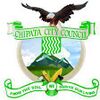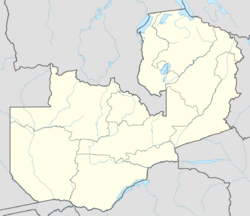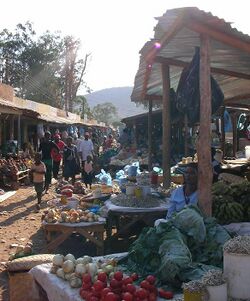Chipata
Topic: Place
 From HandWiki - Reading time: 8 min
From HandWiki - Reading time: 8 min
Chipata | |
|---|---|
City | |
| Chipata | |
 | |
| Coordinates: [ ⚑ ] : 13°38′43″S 32°38′47″E / 13.64528°S 32.64639°E | |
| Country | |
| Province | Eastern Province |
| District | Chipata District |
| Founded | 1898 |
| City status | 2017 |
| Government | |
| • Type | Local Government |
| • Mayor | George Mwanza |
| Area | |
| • Urban | 59.44 sq mi (153.94 km2) |
| Elevation | 3,875 ft (1,181 m) |
| Population (2022) | |
| • City | 327,059 |
| • Density | 501/sq mi (193.4/km2) |
| • Metro | 327,059 |
| Time zone | UTC+2 (CAT) |
| Area code(s) | +260 216 |
| Climate | Aw |
Chipata is a city and administrative centre of the Eastern Province of Zambia and Chipata District. It was declared the 5th city of the country, after Lusaka, Ndola, Kitwe and Livingstone, by President Edgar Lungu on 24 February 2017. The city has undergone rapid economic and infrastructure growth in the years, leading up to city status.[1][2]
Location
Chipata is located on the Great East Road, approximately 570 kilometres (354 mi) east of Lusaka, the capital city of Zambia.[3] This is about 150 kilometres (93 mi) west of Lilongwe, the capital city of Malawi.[4] The geographical coordinates of Chipata are 13°38′43.0″S, 32°38′47.0″E.[5] The average elevation of Chipata is 1,181 metres (3,875 ft), above sea level.[6]
Overview
Having a modern market, a central hospital, shopping malls, a university, some colleges and a number of schools, Chipata is the business and administrative hub of the region. The town boasts a four star hotel, a golf course, an airport, and a "welcome arch". Developed areas includes Kalongwezi, Moth, and Little Bombay.
Chipata is the regional head of the Ngoni of Zambia. The Ngoni adopted the languages of the tribes they conquered, so Chewa and Nsenga are the principal languages, although Tumbuka and English are widely spoken, plus some Indian languages, as a large number of Zambian Indians live in the town. It is located near the border with Malawi, and lies on the Great East Road which connects the capitals Lilongwe 150 kilometres (93 mi) to the east,[4] and Lusaka 570 kilometres (354 mi) to the west.[5] It is a popular access point for the South Luangwa National Park.
History
Chipata's name comes from the Chewa word "Chimpata" meaning "large space", in reference to the town's situation in a shallow valley between hills. The name of the central neighbourhood of Kapata, the original centre of town, comes from the Chewa word meaning "small space."
Chipata was formerly known as Fort Jameson (and informally as "Fort Jimmy"), being named after Sir Leander Starr Jameson, the 19th-century British politician and adventurer. Even during the colonial period, few supported that Jameson, who is mainly known for his part in the infamous Jameson Raid, fully deserved the honour of having any town named after him. Like 'Fort Manning' and 'Fort Rosebery', Fort Jameson was called a "fort" because the local government offices, or "Boma", were once fortified.
Fort Jameson was the capital of the British protectorate of North-Eastern Rhodesia between 1900 and 1911.
During World War II, 80 Polish refugees escaping from German- and Soviet-occupied Poland, were admitted in Fort Jameson in 1941.[7]
Government
The mayor of the city of Chipata is the head of the city government.
Population
With a population of about 455,783 in 2010,[8] the Chipata district is believed to be the 3rd largest district of the country. The city of Chipata had 116.600 inhabitants in 2010.[9] The predominant ethnic groups in the city are the Chewa, Tumbuka, Ngoni and Nsenga.[10]
Economy
Chipata is the primary transport hub for trade between Zambia and Malawi. "Down Shops" is Chipata's bustling down-town area, most shops and other businesses having proprietors of Indian origin. Two notable shops are Kavulamungu Bargain Centre, and Ally & Sons.
Tourism
The Nc'wala ceremony of the Ngoni people takes place at Mutenguleni on the outskirts of Chipata. The ceremony celebrates the first fruits harvest and is usually held at the end of February.[1]
Hospitality
Chipata has five Hotels and several guest houses and lodges dotted across the city that meets international standards. Some of the notable places of accommodation in Chipata include Protea Hotel a three-star Hotel that has been in the city for over 10 years. Crystal Springs Hotel about 1.5km away from town centre as you go towards Malawi is another Hotel with excellent Conference Halls and Swimming pool facilities. It has been in operation for over 25 years. Nyamfinzi Hotel, Fort Jameson and Luangwa House operated by Hostels Board of Zambia.
Other notable guest Houses and Lodges include;
• Dean's Hillview Lodge
• Eastern Comfort Lodge
• Pineview Guest House
• La Rochelle
• Franklin Gardens
• Jemita Guest House
• Dredel Lodge
• Travel Lodge
• Golf Rest House
• Chiwayu Guest House
• Yanja Lodge
• Mama Rula's campsite
• Kigelia Campsite
• Mwana Chanda Lodge
• Mukels Lodge
• Fort Young's Lodge
• Chikhute Guest House
• Wise Donkey Guest House
• Roadside Guest House
• Sunnyside Lodge
• Katuta Lodge
• Crossroads Lodges
• Gloka Guest House
• Calmrest Lodge
• Mercury one Lodge
• CTV Lodge
• Streamside Guest House
• Chipata Motel
• VNT Motel
• Tilandile Guest House
• Murphy Guest House
• Hom's cottage
• Rombando Executive Lodge
• Chansolo Lodge
• Malent
• Escape view Lodge
• New Horizon view Lodge
• Eastlands Lodge
• Redmont Guest House
• Chatowa Lodge
• Kum'mawa Lodge
Transport
Rail
An extension of the Sena railway, connecting the city of Chipata to the territory of Malawi (via Mchinji) was opened in August 2011.[11] Chipata will now act as the Zambian railhead and entry point from Malawi and beyond. In the pipeline since 1982, the short link, about 35 kilometres (22 mi), provides a through-route for rail traffic from Zambia via Malawi to the Indian Ocean deep-water port at Nacala in Mozambique.[12] The route and alignment of the line has been laid out, including the site of Chipata station and the basic station building.[13]
The route will provide an alternative to two existing rail routes to the Indian Ocean, at Dar es Salaam and Beira. In 2015 it was proposed to build a rail link to Serenje, a town on the TAZARA Railway line.[14]
Road
The T4 road (Great East Road) connects Chipata with Lusaka to the west (570 kilometres away) and the Mwami border with Malawi to the east (20 kilometres away).[15]
The M12 road connects Chipata with Lundazi to the north (100 kilometres away).[15] The D104 road connects Chipata with Mfuwe and the South Luangwa National Park to the north-west.[15] The D128 road connects Chipata with Chadiza to the south-west.[15]
Rivers
Chipata has four major streams pouring into the Luangwa river. The Luangwa river rises in the Lilonda and Mafinga Hills in north-east Zambia at an elevation of around 1500 meters near the border with Tanzania and Malawi, and flows in a southwesterly direction through a broad valley.[16] The water from the streams and the Luangwa river is used for farming by the inhabitants around the district.
Soil and Vegetation
There are three main soil types namely Acrisols, Fersiallitic soils, and Lithosols. There are four vegetation types, the main one being the Brachystegia (Miombo) woodland and Munga vegetation types.
Climate
Chipata features a tropical savanna climate (Köppen: Aw)[17] with distinct wet and dry seasons. Summers are characterized by warm to hot temperatures, reaching peak values in October and November. Winters are milder, with July being the coolest month. The wet season, from November to March, experiences high humidity and significant rainfall. The dry season, from May to October, is marked by minimal precipitation.[18]
Script error: No such module "weather box".
Schools & Colleges
Primary education
- SPS (Shakespeare private school)
- Hillside Primary School
- Mpezeni Primary School
- Chipata Primary School
- Kapata Primary School
- Chongololo School
- St Anne's Primary School
- Trinity private School
- Mem private School
- Lunkwakwa Primary school
- St. Betty Primary school
- Munga Primary school
- Mchini Primary school
- Nadalisika primary school
- Msekera primary school
- Walela Primary school
- Madaliso Primary school
- Crownhill School
Secondary education
- Anoya Zulu Boys Secondary School
- Chizongwe Technical Secondary School
- St. Monicas Girls Secondary School
- Chipata Day Secondary School
- Hillside Girls High School
- St. Atanazio Secondary School
- St. Mary's Seminary School
- Damview Secondary School
- Muziphas high school
- Katopola Day secondary school
- Kanjala Day secondary school
- St. Magrets Girls secondary school
- Lutembwe Day secondary school
- Mazimoyo Day Secondary school
- Gondar Day secondary school
Tertiary education
- Chipata Teacher's Training College
- Chipata Trades Training Institute
- Chipata School of Nursing
- DMI-St. Eugene University
Suburbs
- Kalongwezi
- Kalongwezi Extension
- Kapata
- Umodzi
- Moth
- Muchini
- Nabvutika
- Little Bombay
- Mchenga
- Damview
- Old Gym
- New Gym
- Chimwemwe
- Magazine
- Eastrise
- Walela
- Chawama
- Munga
- Chipata Motel
- Nadalitsika
- Katopola
- Maferendum
- Rose
- Hillview
- Gash
- Msekera
- Messengers
- David Kaunda area
- Hollywood
- Kalongola site and service
- Hillview
- Chimzere
- Gondar Barracks
- Highlands
- Aslot
See also
- Railway stations in Zambia
- Railway stations in Malawi
- Transport in Zambia
- Transport in Malawi
References
- ↑ 1.0 1.1 Mwendabai, Darlington (25 February 2017). "Chipata: Newest city on the hills". Lusaka. http://www.daily-mail.co.zm/chipata-newest-city-on-the-hills/.
- ↑ "Times of Zambia". 2020-05-30. https://www.times.co.zm/?p=94070.
- ↑ Globefeed.com (22 November 2018). "Distance between Lusaka, Zambia and Chipata, Zambia". Globefeed.com. https://distancecalculator.globefeed.com/Zambia_Distance_Result.asp?fromplace=Lusaka%2C%20Zambia&toplace=Chipata%2C%20Zambia&dt1=ChIJSaq8PH3zQBkR6xMgRsGT0NA&dt2=ChIJpXP06sXrGBkR9XzTViAfdgY&sr=dc.
- ↑ 4.0 4.1 Viajes Con Mochila (September 2015). "Traveling through Zambia with backpack. Chipata to Lilongwe (it´s only 150 km)". Nomad-as.com. http://www.nomad-as.com/2015/09/traveling-through-zambia-with-backpack.html.
- ↑ 5.0 5.1 "Location of Chipata, Zambia". https://www.google.com/maps/place/13%C2%B038'43.0%22S+32%C2%B038'47.0%22E/@-13.633657,32.6446554,4096m/data=!3m1!1e3!4m5!3m4!1s0x0:0x0!8m2!3d-13.6452778!4d32.6463889.
- ↑ Floodmap.net (22 November 2018). "Elevation of Chipata, Zambia". Floodmap.net. http://www.floodmap.net/elevation/ElevationMap/?gi=918702.
- ↑ Wróbel, Janusz (2003) (in pl). Uchodźcy polscy ze Związku Sowieckiego 1942–1950. Łódź: Instytut Pamięci Narodowej. p. 137. ISBN 978-83-7629-522-0.
- ↑ Central Statistical Office Zambia (14 November 2018). "The Population of Chipata in 2010". Citypopulation.info Quoting Central Statistical Office Zambia. http://www.citypopulation.info/php/zambia-admin.php?adm1id=03.
- ↑ Largest cities of Zambia retrieved 20 June 2019
- ↑ University, Africa EENI Global Business School &. "Study in Chipata (Oriental province, Zambia)" (in en). https://www.hauniversity.org/en/Zambia-Chipata.shtml.
- ↑ Afrol Staff Writer (21 September 2011). "Zambia, Malawi finally connected by rail". Kroderen, Norway: Afrol.com. http://www.afrol.com/articles/36610.
- ↑ News Agencies (26 August 2007). "New rail link to boost Southern African trade" (Archived from the original). Mail&Guardian Online. http://www.mg.co.za/articledirect.aspx?articleId=317537.
- ↑ Google. "Location of Chipata Railway Station" (Map). Google. Missing or empty
|title=(help) - ↑ Community News (3 August 2017). "Chipata-Tazara railway project hits a snag". Chipata, Zambia: Breeze FM Chipata. http://breezefmchipata.com/?p=9367.
- ↑ 15.0 15.1 15.2 15.3 "Roads and Road Traffic Act | National Assembly of Zambia". https://www.parliament.gov.zm/node/1492.
- ↑ "Luangwa River In Zambia" (in en-US). https://www.victoriafalls-zambiatravel-safaris.com/country-info/rivers/luangwa-river.
- ↑ "Table 1 Overview of the Köppen-Geiger climate classes including the defining criteria." (in en). Nature: Scientific Data. 23 October 2023. https://www.nature.com/articles/s41597-023-02549-6/tables/1.
- ↑ 18.0 18.1 "World Meteorological Organization Climate Normals for 1991-2020 — Msekera". National Oceanic and Atmospheric Administration. https://www.nodc.noaa.gov/archive/arc0216/0253808/2.2/data/0-data/Region-1-WMO-Normals-9120/Zambia/CSV/Msekera_67580.csv.
- ↑ "Chipata MET Climate Normals 1961–1990". National Oceanic and Atmospheric Administration. ftp://ftp.atdd.noaa.gov/pub/GCOS/WMO-Normals/TABLES/REG__I/ZA/67581.TXT.
External links
| Wikivoyage has a travel guide for Chipata. |
 |
 KSF
KSF




